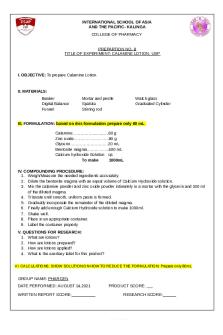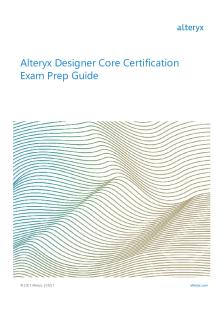Prep Guide 8 Key PDF

| Title | Prep Guide 8 Key |
|---|---|
| Author | Brandon Piccinini |
| Course | Introduction to Psychology |
| Institution | Auburn University |
| Pages | 3 |
| File Size | 80.5 KB |
| File Type | |
| Total Downloads | 83 |
| Total Views | 145 |
Summary
Answers to the eighth prep guide for exam 2...
Description
PSYC 2010-008 FA 2016
Prep Guide 8 Key Chapter 8: Thinking, Language, and Intelligence Full name: _________________________________
1. What is the difference between analogical and symbolic representations? Analogical representations used shared characteristics, such as an image representing an item or relationship, whereas symbolic representations are arbitrary. This means symbolic representations contain no objective information that corresponds to the concept it represents, but is instead a learned association. 2. What are one advantage and one disadvantage to using schemas or scripts? Advantages of schemas and scripts include reducing the time it takes to make a decision, and disadvantages include making biased decisions or holding prejudicial stereotypes. 3. What are the four common heuristic biases? Provide an example (not listed in the text) of each. Relative comparisons can influence how people feel about decisions our outcomes. The same option may look more or less attractive when paired with different alternatives. For example, one average-looking potential dating partner may look attractive to you when near a person of less-than-average attractiveness, but may look unattractive to you when they are near a very attractive person. The availability heuristic influences people to make decisions using either the first or most easily accessible piece of information they have. We used the information we’re exposed to more often to make judgments about the world as a whole. For example, some European American students are surprised to learn that White people are a minority worldwide, because they are surrounded by other European Americans. The representativeness heuristic biases us to ignore base rate information. We decide whether one case is more representative of a general group, rather than using the base rat (percentage) information to determine whether one case is more likely to be a member of one group or another. For example, when given a profile of a vegan animal rights activist and asked whether they vote Green Party or Republican, you may choose “Green Party” because of you believe the characteristics are representative of Green Party voters, when in fact the vegan activist is more likely a Republican than a Green Party voter because Republicans are far more common (by a few orders of magnitude) than Green Party adherents. The affective heuristic involves a bias in predicting emotions. People are not good affective forecasters, and often overestimate both their positive and negative emotions in response to a hypothetical future event. For example, many people predict they will be unhappy enough to stop functioning after a tragedy, but in reality most people cope and resume functioning well. 4. What is functional fixedness?
PSYC 2010-008 FA 2016
Prep Guide 8 Key Chapter 8: Thinking, Language, and Intelligence
Functional fixedness is the inability to think of alternative uses for an object or idea when trying to solve a problem. Being able to overcome functional fixedness, or think “outside the box” to come up with alternative uses for common objects can be very useful when solving new or difficult problems. 5. What is linguistic relativity theory? Generate an example of this that is not found in the text. Linguistic relativity theory holds that language determines thought; people can only think of concepts for which they have words in the languages they understand. A weaker version holds that language can influence thought. For example, in many Romance languages nouns have gender. People who speak Romance languages may think of common objects as having gender-stereotypical characteristics, whereas people who speak languages without gendered nouns might view the same objects as having no gender-related characteristics. 6. What are the differences between how other animals, such as chimpanzees, communicate and how humans use language? Some non-human animals can generate different sounds that signal distinct meanings and behaviors in members of the same species. Some can also learn to use symbolic representations of words or concepts to explain their needs to humans. However, humans generate spontaneous speech that goes beyond communicating needs, and regardless of what languages we may speak, we arrange words in systematic ways that can communicate different meanings. Non-human animals do not generate such spontaneous speech, nor do they master syntax (sequences of words as determinant of different meanings). 7. What is the difference between fluid intelligence and crystallized intelligence? Summarize the research on how they change over age and what outcomes they predict. Fluid intelligence involves abstract reasoning and logical thinking, and does not require prior experience with the subject material, whereas crystallized intelligence refers to using acquired knowledge from experience to solve problems. Fluid intelligence is similar to working memory, and crystallized intelligence is most similar to long-term memory. Fluid intelligence declines throughout life after early adulthood, whereas crystallized intelligence grows throughout the lifespan until cognitive decline in advanced age. 8. What is stereotype threat and how does it relate to intelligence testing? Stereotype threat refers to the mental activation about a stereotype of a group to which you belong, which then paradoxically results in behavior consistent with the stereotype. During intelligence testing and other cognitive tests, when people are confronted with pressure related to stereotypes about groups to which they belong, they may underperform relative to their true abilities because of the discouraging unconscious influence of the stereotype. 9. For the following example, decide which decision-making concept is being illustrated: expected utility theory, framing, an availability heuristic, or a representative heuristic. Explain your answer. A pharmaceutical company wants to increase the sales of its new heart medication,
PSYC 2010-008 FA 2016
Prep Guide 8 Key Chapter 8: Thinking, Language, and Intelligence
so it includes information that says "75 percent of patients using this drug experience no side effects" instead of saying that "25 percent of patients using this drug experience side effects." Framing, because the information in both lines are the same, but one uses a positive frame (focusing on how many people feel no side effects), whereas the one the company did not use focuses with a negative frame (by listing how many people experienced side effects). 10. Greg is trying to decide what to order for dinner. To do this, he considers each alternative, ranks them in order of preference, and chooses the one that is most desirable. Which type of decision making is Greg illustrating: expected utility theory, framing, an availability heuristic, or a representative heuristic? Explain your answer. Greg is behaving in accordance with expected utility theory. Instead of using a heuristic to make his decision, such as going for the food that he thought of first or saw on an advertizement, he systematically decides based on which choice yields the most valuable outcome for him. 11. Miguel has a fever, a sore throat, and a rash. He is trying to figure out what is wrong with him. He quickly and easily recalls the show he just finished watching about Ebola and decides he must have Ebola. Which type of decision making is Miguel illustrating: expected utility theory, framing, an availability heuristic, or a representative heuristic? Explain your answer. Miguel’s self-diagnosis is based on an availability heuristic, because Ebola was easily available in his memory from having recently watched a television program featuring it. 12. We make decisions and solve problems every day. The decision-making research described in this section could impact how you solve your own problems. First, describe a problem you are currently working on solving or a decision that you are currently trying to make. Then, describe how some of the heuristics listed in this section might influence your decision-making or problem-solving process. Finally, describe how some of the problem-solving strategies might help you make a better decision or solve your problem more efficiently. Answers will vary....
Similar Free PDFs

Prep Guide 8 Key
- 3 Pages

PREP GUIDE CHAPTER 8
- 2 Pages

Postpartum PREP Guide-
- 5 Pages

Proctored prep U Answer key
- 117 Pages

PREP 8 Calamine- Phar Cen
- 7 Pages

Core Certification Exam Prep Guide
- 12 Pages

Chapter 8 Quiz KEY
- 1 Pages

NERO142 Answer Key 8
- 4 Pages

Study guide key
- 8 Pages

Test4Review KEY - Study Guide
- 4 Pages

Macroe Study Guide Key
- 18 Pages
Popular Institutions
- Tinajero National High School - Annex
- Politeknik Caltex Riau
- Yokohama City University
- SGT University
- University of Al-Qadisiyah
- Divine Word College of Vigan
- Techniek College Rotterdam
- Universidade de Santiago
- Universiti Teknologi MARA Cawangan Johor Kampus Pasir Gudang
- Poltekkes Kemenkes Yogyakarta
- Baguio City National High School
- Colegio san marcos
- preparatoria uno
- Centro de Bachillerato Tecnológico Industrial y de Servicios No. 107
- Dalian Maritime University
- Quang Trung Secondary School
- Colegio Tecnológico en Informática
- Corporación Regional de Educación Superior
- Grupo CEDVA
- Dar Al Uloom University
- Centro de Estudios Preuniversitarios de la Universidad Nacional de Ingeniería
- 上智大学
- Aakash International School, Nuna Majara
- San Felipe Neri Catholic School
- Kang Chiao International School - New Taipei City
- Misamis Occidental National High School
- Institución Educativa Escuela Normal Juan Ladrilleros
- Kolehiyo ng Pantukan
- Batanes State College
- Instituto Continental
- Sekolah Menengah Kejuruan Kesehatan Kaltara (Tarakan)
- Colegio de La Inmaculada Concepcion - Cebu




